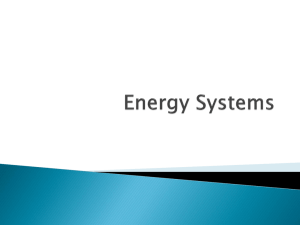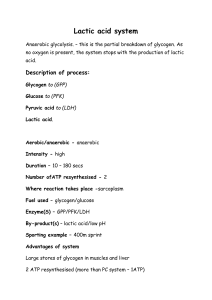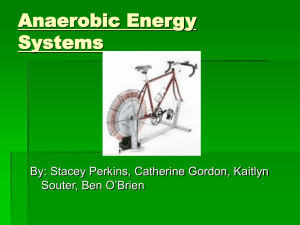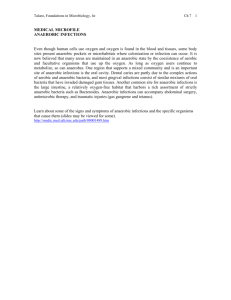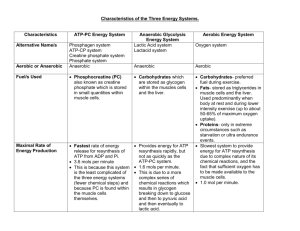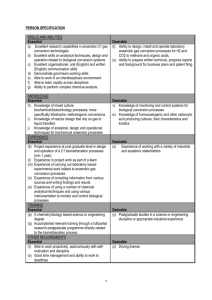Anaerobic Power & Capacity - SHMD 349 Sport & Exercise
advertisement
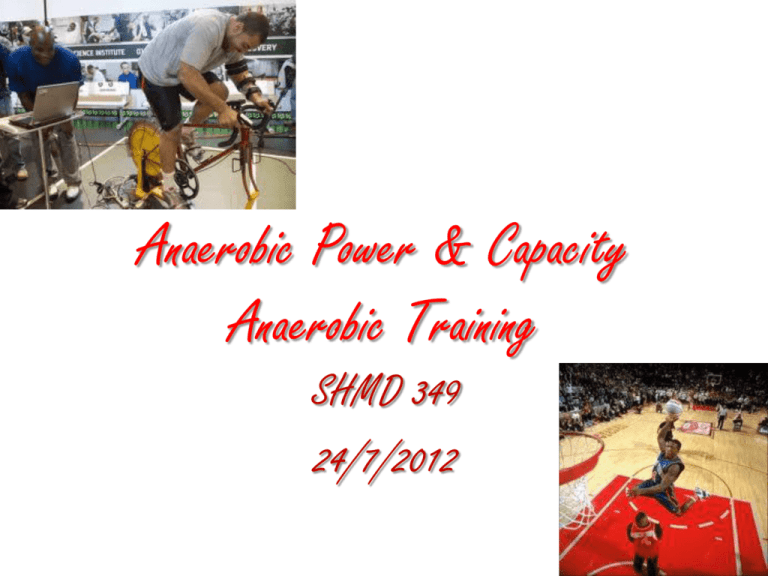
Anaerobic Power & Capacity Anaerobic Training SHMD 349 24/7/2012 What Is Anaerobic Exercise? • Anaerobic exercises do not use oxygen in the process of supplying energy to the body. • Exercises are high intensity. • 80 – 95% heart rate maximum. • You do not have to ‘breathe’ to talk while participating: example– Sprinting, high jump, speed swimming & 400m running. Phosphocreatine Energy System • The function of energy systems is to produce ATP to make our muscles contract. • ATP is not stored in large amounts in skeletal muscle and therefore has to be continually made for our muscles to contract continually. • At the onset of exercise, the energy system that supplies energy is called the phosphocreatine (PC) system. It supplies energy much quicker than any other system as it produces energy in the absence of oxygen. • PC stores are used for rapid, high-intensity contractions; but only last for about 10 seconds. Lactic Acids Energy System • Once the PC stores run out, the lactic acid system is used, also known as anaerobic glycolysis (breakdown of glucose in the absence of oxygen). • The by-product of this system is lactic acid. • This system produces ATP very quickly, but not as quickly as the PC system. • This system is generally used for high intensity exercise lasting between 30 seconds and three minutes. • Example: 800m race. Fatigue • We cannot continue with exercise indefinitely because we will eventually fatigue. • Fatigue: tiredness from physical exertion. • Fatigue occurs due to a number of factors: – Depletion of energy sources: glucose, glycogen, phosphocreatine. – Effects of waste products: increased production of lactic acid & carbon dioxide. • Thus you need to rest in order to recover and return the body to preexercise state. Recovery • Four events must take place before the muscle can operate again: 1. ATP must be replaced. (3 minutes) 2. PC stores must be replenished. (3 minutes) 3. Lactic acid must be removed. (20 minutes) 4. Glycogen stores must be replenished. (24 – 48 hours) • High intensity exercise = longer recovery period. • Higher fitness level = faster recover period. Training Anaerobic Systems • Training to improve the ATP-PC System • Sports such as weight lifting & 100m sprints depend on this system to provide the most energy for competition. • To maximally stress the ATP-PC pathway: short, high intensity intervals (5-10 second durations) using the muscles utilized in competition are ideal. • Little lactic acid is produced & recovery is rapid. • The rest interval may range between 30 & 60 seconds, depending on fitness level of the athlete. Training Anaerobic Systems • Training to improve the Glycolytic system • After 10 seconds of maximal effort, energy production then comes from anaerobic glycolysis. • To improve the capacity of this energy pathway, the athlete must overload the system with high intensity intervals of 20 – 60 second duration. • This type of training is both physically and psychologically demanding, requiring a high level of commitment from the athlete. • This type of training drastically reduces glycogen stores. Anaerobic Program Example • Lactic Acid System • 6 sets of 45 seconds (300m) at 90 – 95% effort with 90 seconds rest. • 4 sets of 75 seconds (500m) at 80 – 85% effort with 150 seconds rest. • ATP/PC System • 10 sets of 50 meters at 100% effort with 1 minute rest. Anaerobic Program • Fartlek: Speed play • Running at a different range of speeds. • 20 – 30 minutes in total. • Involves a base speed at 60 – 70% of maximum intensity, with bursts of work at 75, 80, 85 or 90%. • Excellent for replicating demands in sports such as football, rugby or hockey; where types of running are required at different times. • Can also be used in cycling or rowing training. • Reduce boredom of training for long periods of time. Anaerobic Tests • Vertical Jump • Standing Broad Jump • 40 yard dash • Wingate cycle test Revision Questions 1. 2. 3. 4. 5. Define Fartlek, and briefly explain how this type of training is performed. 5 Which sports would use Fartlek as a training method? 3 What types of exercises use the anaerobic energy system? 2 At what intensity is the anaerobic energy system used? 1 Briefly compare the phoshocreatine energy system and the lactic acid energy system; referring to the type of exercise performed, when this system is used and how long energy can be supplied for. 10 6. What is fatigue and why does it occur? 5 7. Explain the recovery process of a muscle. 10 8. How would you train to improve the ATP-PC system? 5 9. How would you train to improve the glycolytic system? 4 10. Name 2 anaerobic tests used to test anaerobic power. 2

